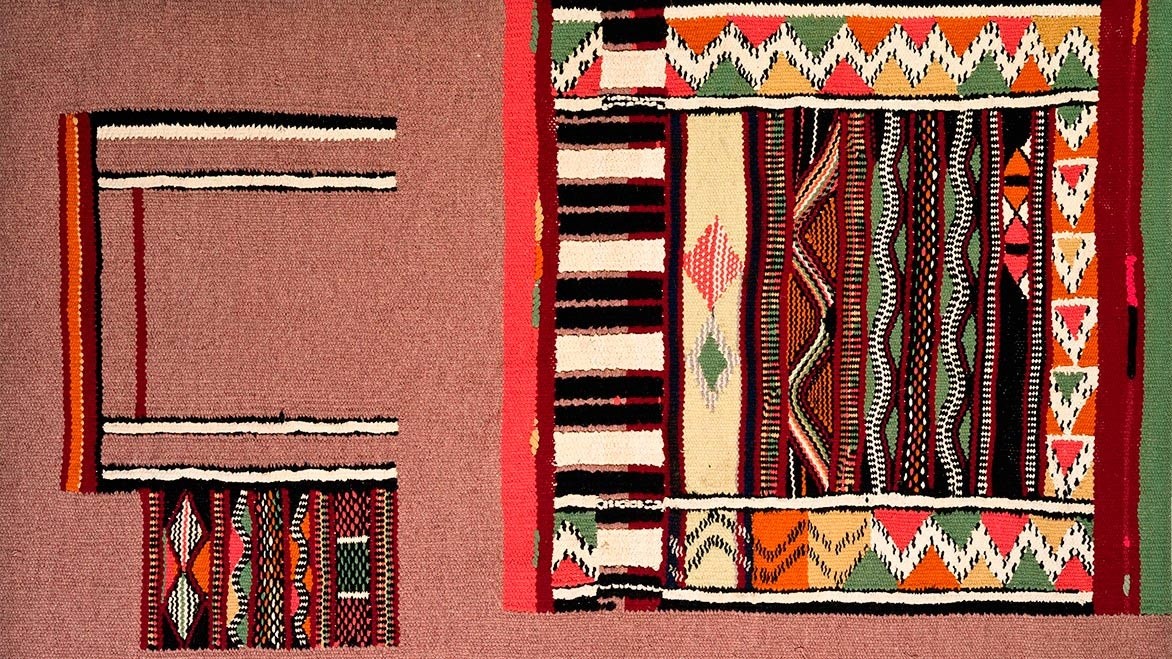Teresa Lanceta
Farewell to the Rhombus
10 Jun - 18 Sep 2016
TERESA LANCETA
Farewell to the Rhombus
10 June to 18 September 2016
Teresa Lanceta immersed herself in the weaving communities of the Middle Atlas, and through their textile traditions—a secret passed down from generation to generation—her eyes were opened to a collective discovery that has helped people to live, communicate and endure: an art marked by ancient habits, motifs and rules which, when mastered, allowed expressive freedom and creativity.
In the early 1970s, Lanceta decided to embrace weaving as a medium of artistic expression, stretching the limits of comprehension of what can or cannot be considered art. Her approach to weaving focuses on the formal elements, on the original, inherent aspects of woven fabric: its ligaments, materials, traditions and techniques. She does not use preliminary designs or sketches; in her modus operandi, she simultaneously constructs picture and ground, object and language, support and image, and mistakes do not exist.
Weaving has allowed Lanceta to understand a primeval, universal code that reveals its internal law, a law that transcends physical, temporal and cultural borders while also fuelling the creative imagination which she uses to devise a highly personal proposal. Her work does not shy away from ecological reflections and advocates the utility of art and collective creation as opposed to the idea of individual genius. Collective art is presented not as a uniform magma or an enormous hand that makes everything, but as the product of the pooled creativity of concrete individuals, an open-source code that allows it to be read, transformed and transmitted.
The productive time of the nomadic weaver-women of the Middle Atlas is the time of life itself, just another part of daily life that allows personal stories, events and experiences to impregnate the warp and weft of their creations. Craft and creativity are united in those supreme moments that transform the familiar and offer a glimpse of the hidden. The weaves transcend their decorative purpose or symbolic function: they form part of a way of life and a shared, everyday knowledge and, as such, deploy their ornamental and artistic power.
For all of these reasons, Farewell to the Rhombus is a point of departure, the statement of a poetic and political position on a way of approaching the world that is no longer possible and is beginning to reveal its bitterest side.
The show, curated by Nuria Enguita, features woven fabrics, paintings, drawings, a text and several videos compiled from the artist’s interviews with the women of that region and relatives who immigrated to Spain. In addition to Lanceta's work, the exhibition includes documentation on folk art from regions bordering the Sahara and the work of young artists interested in traditional craftsmanship. There are also two collaborative creations: a digital map of patterns and objects of the Middle Atlas, created with Nicolas Malevé, and an interactive audio installation based on algorithms, produced with Lot Amorós.
Farewell to the Rhombus
10 June to 18 September 2016
Teresa Lanceta immersed herself in the weaving communities of the Middle Atlas, and through their textile traditions—a secret passed down from generation to generation—her eyes were opened to a collective discovery that has helped people to live, communicate and endure: an art marked by ancient habits, motifs and rules which, when mastered, allowed expressive freedom and creativity.
In the early 1970s, Lanceta decided to embrace weaving as a medium of artistic expression, stretching the limits of comprehension of what can or cannot be considered art. Her approach to weaving focuses on the formal elements, on the original, inherent aspects of woven fabric: its ligaments, materials, traditions and techniques. She does not use preliminary designs or sketches; in her modus operandi, she simultaneously constructs picture and ground, object and language, support and image, and mistakes do not exist.
Weaving has allowed Lanceta to understand a primeval, universal code that reveals its internal law, a law that transcends physical, temporal and cultural borders while also fuelling the creative imagination which she uses to devise a highly personal proposal. Her work does not shy away from ecological reflections and advocates the utility of art and collective creation as opposed to the idea of individual genius. Collective art is presented not as a uniform magma or an enormous hand that makes everything, but as the product of the pooled creativity of concrete individuals, an open-source code that allows it to be read, transformed and transmitted.
The productive time of the nomadic weaver-women of the Middle Atlas is the time of life itself, just another part of daily life that allows personal stories, events and experiences to impregnate the warp and weft of their creations. Craft and creativity are united in those supreme moments that transform the familiar and offer a glimpse of the hidden. The weaves transcend their decorative purpose or symbolic function: they form part of a way of life and a shared, everyday knowledge and, as such, deploy their ornamental and artistic power.
For all of these reasons, Farewell to the Rhombus is a point of departure, the statement of a poetic and political position on a way of approaching the world that is no longer possible and is beginning to reveal its bitterest side.
The show, curated by Nuria Enguita, features woven fabrics, paintings, drawings, a text and several videos compiled from the artist’s interviews with the women of that region and relatives who immigrated to Spain. In addition to Lanceta's work, the exhibition includes documentation on folk art from regions bordering the Sahara and the work of young artists interested in traditional craftsmanship. There are also two collaborative creations: a digital map of patterns and objects of the Middle Atlas, created with Nicolas Malevé, and an interactive audio installation based on algorithms, produced with Lot Amorós.

